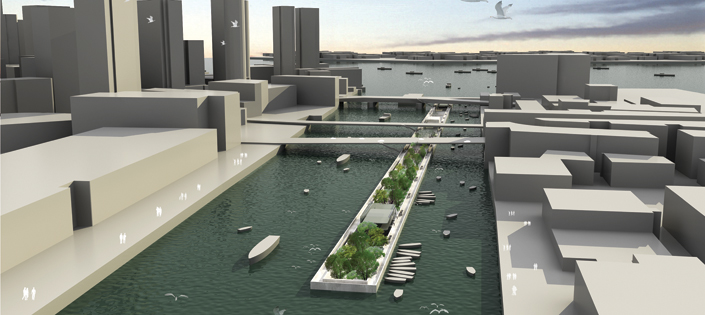The city can return to be a space inhabited by animals. A livable city is also measured by its ability to integrate and include forms of life complementary to the human being. A large dam divides
the Fourt Point Channel into two parts.
Firstly, it is a device to define the Channel geometrically, creating two new basins. The first basin is large and used by commercial boats. The second one is smaller and reserved to pleasure crafts, tourism
and sport activities. The dam works as a large environmental machine and it characterizes the two basins. In its base there is a system of pumps that drives the sea water from the larger Channel into the dam, where specific botanic species eliminate its polluting substances, thanks to the evapotranspiration system principle. Afterwards the clean water is let in the small Channel, where it allows the presence of water animals (shellfishes, seashells, anemones, algae) and of different sport and pleasure craft activities.
Secondly, the dam is inhabited. Its thickness hides a large corridor that reproduce the habitat of the Boston Harbor Islands. Air, land and water animals aggregate, nest and rest on the dam and around it. The new dam is an outstanding point in the natural spaces of the Boston bay. It gives a pragmatic contribution to the environmental network, especially for the air animals that cross the sky of the Boston bay, which is one of the richest urban spaces in the United States from a faunal point of view. Then, the dam is a public space. In certain periods of the year or of the day it is open to public walks, tourists and concerned
people. The dam integrates efficiently with some touristic places of the context, like the Children Museum in front of it. From the existing bridges, citizens step down to the dam along its borders, where there is a promenade that allows people walking, looking both water and animals, listening sounds and appreciating the city’s skyline from a new point of view. A new perception of an extreme and peculiar urban experience will grow up. The land animals represent particular species in the dam. Only some of them (Sciurus carolinensis, Mephitis mephitis, Peromyscus leucopus,Plethodon cinereus, Emydoidea blandingii,
Chelydra serpentina) can be hosted permanently on it, thanks to their unique characteristics of adaptability to the local environment. The others, which are larger in amount, can live in the dam for medium or long periods, under the observation of researchers and specialized centers from the local Universities.
design team: im studio mi/la with Barreca & La Varra / collaborators: n. golkar, v. lulhi, s. lora, z. xuan






